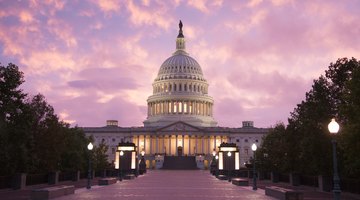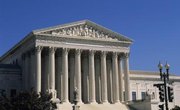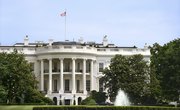The United States exemplifies an ideal structure of democratic governance. Designed to provide a system of checks and balances, the federal government is composed of three equal branches: the executive, the legislature and the judiciary. The drafters of the U.S. Constitution created a central government in which the ability to create, implement and enforce laws are not consolidated in the hands of one authority. Each branch of power is balanced by powers of the other two: The president can veto the laws of Congress, Congress can approve or reject presidential appointments as well as remove the president from office in special circumstances and the justices of the U.S. Supreme Court can overturn laws it deems unconstitutional.
Legislative Branch
Congress is composed of the House of Representatives and the Senate. Congress has the sole authority to enact legislation, establish a budget for the federal government, and declare war on behalf of the United States. The Senate maintains the power to ratify treaties by a two-thirds majority vote and confirm presidential appointments by a majority vote.
Executive Branch
The President of the United States leads the executive branch; the president acts as the head of state and Commander-in-Chief of the armed forces. Article II of the Constitution states the president is responsible for executing and enforcing the laws approved by Congress. The President also has the power to appoint the heads of 15 executive departments – who make up the president’s Cabinet – as well as the heads of more than 50 independent federal commissions. Upon receiving legislation from Congress, the president can either sign it into law or veto it. Congress can override a presidential veto with a two-thirds majority vote in both houses.
Judicial Branch
The judicial branch of the federal government, outlined by Article III of the Constitution, includes the Supreme Court of the United States and federal district courts created by Congress. Members of the judicial branch are appointed by the President and confirmed by the Senate. The Supreme Court, the highest court in the nation, has the power to interpret laws according to the Constitution. Article III grants Congress the authority to establish courts inferior to the Supreme Court, which try most federal cases
Separation of Powers
The term “separation of powers” is credited to Charles-Louis de Secondat, an 18th century French political philosopher whose writing influenced the Constitution. This allows each branch to function independently, but one cannot act without approval from the other. However, examples of such a system can be found far before the 1700s. The Ancient Athenians, who created the world’s first known direct democracy, briefly established a democratic government consisting of three branches: the Assembly, the Council of 500 and the Courts. The government during the Roman Republic, consisting of the Roman Senate, Consuls and Assemblies, is another early example of separation of powers.
Related Articles
References
Writer Bio
Ashley Portero has been covering state and national politics since 2011. Her work has appeared in "The Boston Globe," "The Boston Business Journal" and the "International Business Times." She received a Bachelor of Science degree in journalism from Emerson College.











